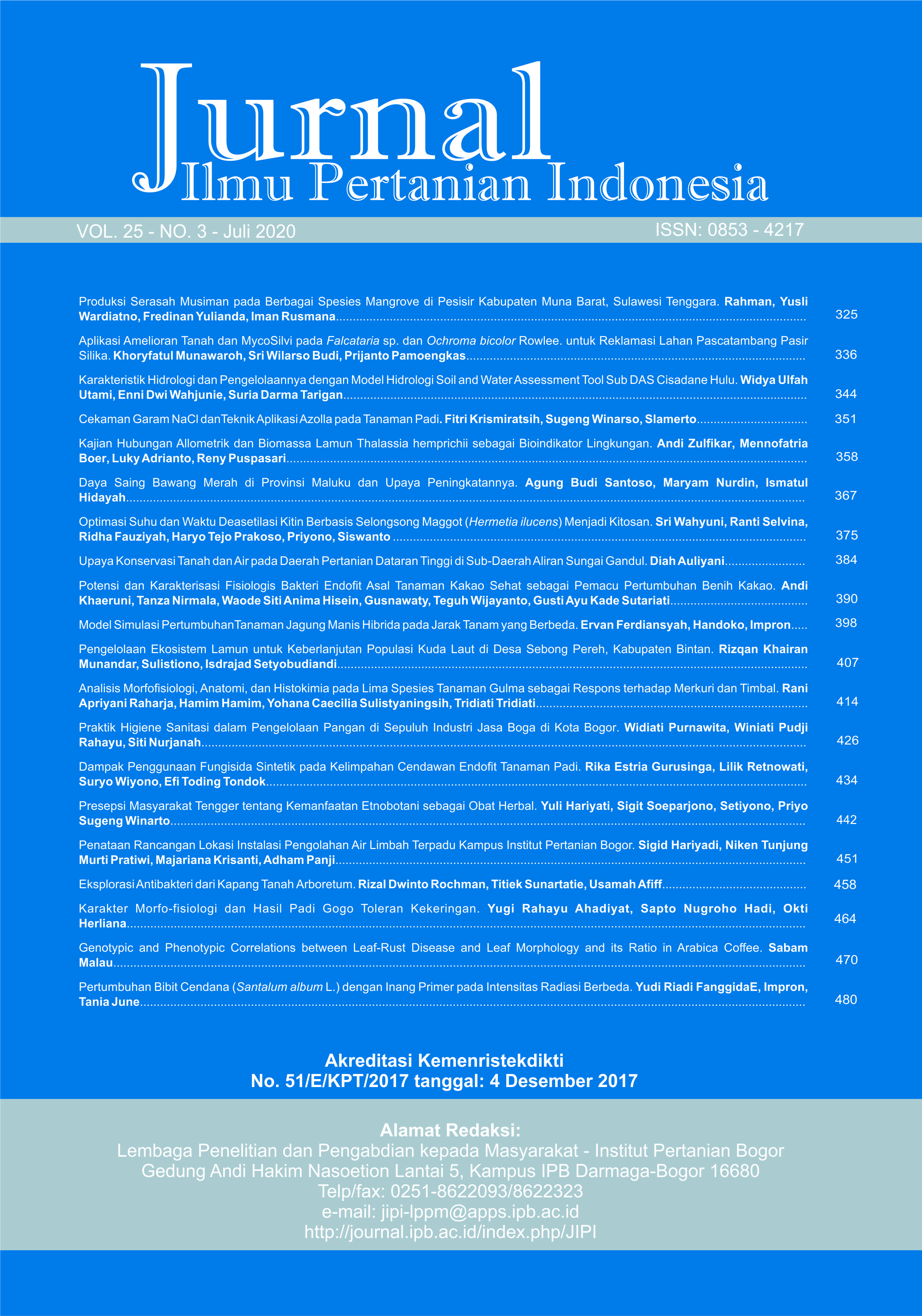Penataan Rancangan Lokasi Instalasi Pengolahan Air Limbah Terpadu Kampus Institut Pertanian Bogor
Abstract
Until now there has not been a centralized Wastewater Treatment Plant (WWTP) in IPB, even though there are wastewater treatments in several locations that are scattered in the campus area. Various activities on the Dramaga IPB campus have the potential to produce wastewater, such as laboratory activities, especially chemical and biological laboratories, canteens, offices, and dormitories. The existence of scattered laboratories requires a centralized and integrated WWTP. For this reason, mapping of wastewater distribution is needed to arrange the location of the wastewater treatment plant, within the campus. Interviews with the perpetrators of activities, measurement of wastewater quality, and sampling, were carried out at the work units producing wastewater on the campus of IPB. The distribution of wastewater was grouped according to the location of the work units producing waste and identified the types of waste produced (B3-dangerous and toxic and non-B3), then presented in a map. The map was used as a reference in determining the location of wastewater treatment plants. The results showed that each work unit contributes organic waste that was not too different, the source of inorganic and B3 wastewater distribution followed the location of the laboratory which was also quite scattered in the Dramaga IPB campus area. Based on the distribution of available waste, the presence of wastewater in the campus environment of IPB was divided into two regional groups. Therefore, the location of the wastewater treatment plant was directed at two locations, namely on the Northeast side (IPAL I) and the West side (IPAL II) of IPB campus.
Keywords: wastewater characteristics, wastewater distribution, wastewater treatment plant
Downloads
References
Anggarini NH, Stefanus M, Prihatiningsih. 2014. Pengelolaan dan karakteristik limbah B3 di PAIR berdasarkan potensi bahaya. Jurnal Bioteknologi. 5 (1): 41-49.
[APHA] American Public Health Association. 2017. Standard Methods for the Examination of Water and Wastewater. 23rd ed. American Public Health Association, American Water Works Association, Water Environment Federation
Asano T, Burton FL, Leverenz HL, Tsuchihashi R, Tchobanoglous G. 2007. Water Reuse: Issues, Technologies, and Applications. Metcalf & Eddy, Inc. The McGraw-Hill Companies, Inc. New York.
Boyd CE. 2000. Water quality: an introduction. New York (US). Springer Science+Business Media. https://doi.org/10.1007/978-1-4615-4485-2_1
Grd, Dijiana, Dobsa J, Simunic-M V, Tompic T. 2012. Analysis of Heavy Metals Concentration in Wastewater along Highways in Croatia. Journal of Computing and Information Technology. 5 (20): 209215. https://doi.org/10.2498/cit.1002099
Humas IPB. 2014. Institut Pertanian Bogor (IPB) Status: Perguruan Tinggi Negeri Badan Hukum (PTN-BH) [Internet]. [diunduh 2020 Mei 18]; 1-11. Tersedia pada: https://ipb.ac.id/media/docu-ment/pdf/profil-ipb-2014.pdf
Khalid M. 2013. Perencanaan Sistem Penyaluran Air Limbah Laboratorium di Kampus IPB Dramaga, Bogor. [skripsi]. Bogor (ID): Institut Pertanian Bogor.
Legendre L, Legendre P. 1983. Numerical Ecology. AMSTerdam (NL): Elsevier Scientific Publishing Company.
Metcalf, Eddy. 2003. Wastewater Engineering: Treatment and Reuse. 4th ed. (Revised by: G Tchobanoglous, FL Burton, HD Stensel). Boston, New York (US): McGraw-Hill Company, Inc.
Permen LH. 2014. Peraturan Menteri Lingkungan Hidup Republik Indonesia Nomor 5 Tahun 2014 tentang Baku Mutu Air Limbah. Jakarta (ID).
Raimon. 2011. Pengolahan air limbah laboratorium terpadu dengan sistem kontinu. Jurnal Dinamika Penelitian Industri. 22(2): 18-27.
Said M. 2009. Pengolahan air limbah laboratorium dengan menggunakan koagulan alum sulfat dan poli aluminium klorida (PAC). Jurnal Penelitian Sains.12(8):38-43.
Sumantri A, Cordova MR. 2011. Dampak limbah domestik perumahan skala kecil terhadap kualitas air ekosistem penerimanya dan dampaknya terhadap kesehatan masyarakat. Journal of Natural Resources and Environmental Management. 1(2): 127.
Suoth AE, Nazir E. 2016. Karakteristik air limbah rumah tangga (Grey Water) pada salah satu perumahan menengah keatas yang berada di Tangerang Selatan. Journal Ecolab. 10(2): 47-102. https:// doi.org/10.20886/JKLH.2016.10.2.80-88
Suprihatin, Indrasti NS. 2010. Penyisihan logam berat dari limbah cair laboratorium dengan metode presipitasi dan adsorpsi. Makara Sains. 14(1): 44-50. https://doi.org/10.7454/mss.v14i1.473
[UU] Undang Undang Nomor 32 Tahun 2009 tentang Perlindungan dan Pengelolaan Lingkungan Hidup. Jakarta (ID).
Wilyanda, Yelmida, Chairul. 2015. Pengolahan limbah cair logam berat (Limbah B3) secara presipitasi dan koagulasi di UPT pengujian dinas pekerjaan umum. Jurnal Online Mahasiswa Fakultas Teknik Universitas Riau. 2(2): 1-10.
This journal is published under the terms of the Creative Commons Attribution-NonCommercial 4.0 International License. Authors who publish with this journal agree to the following terms: Authors retain copyright and grant the journal right of first publication with the work simultaneously licensed under a Creative Commons Attribution-NonCommercial 4.0 International License. Attribution — You must give appropriate credit, provide a link to the license, and indicate if changes were made. You may do so in any reasonable manner, but not in any way that suggests the licensor endorses you or your use. NonCommercial — You may not use the material for commercial purposes.






















